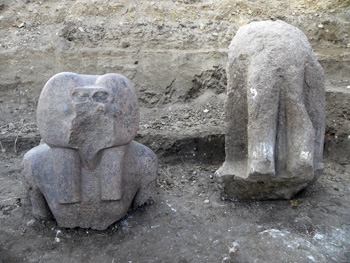Egyptian Statue Fragments Unearthed

Egyptian archaeologists have uncovered two granite statue fragments from the mortuary temple of King Amenhotep III, who reigned for 39 years in the 14th century BC.
The fragments were found during a routine excavation on the north side of the temple, which is on the west bank of the Nile in the city of Luxor, according to Egyptian Minister of Culture Farouk Hosny. The funerary complex there was once the largest in Egypt. The temple itself was eventually destroyed, its blocks recycled to build other temples.
The first statue fragment is a nearly 9-foot (2.7 meter) tall head of the baboon-faced god Hapi, Zahi Hawass, the secretary general of Egypt's Supreme Council of Antiquities, said in a statement. The second fragment is part of a larger statue of King Amenhotep III, depicting the monarch's legs.
Because so many statues are found in this area of the temple, Hawass believes the spot may have been a burial place for damaged statues. The statues were ritually significant and could not be destroyed, so the ancient Egyptians may have buried them instead. [Read: 200 Ancient Egyptian Artifacts Recovered from Bank Vault]
Excavators are now working to uncover more statues from the land surrounding the temple. So far, the team has discovered five double statues of the king accompanied by deities.
- Image Gallery: Amazing Egyptian Discoveries
- Image Gallery: The Seven Ancient Wonders of the World
- Countdown: The World's Longest Rivers
Get the world’s most fascinating discoveries delivered straight to your inbox.
 Live Science Plus
Live Science Plus






